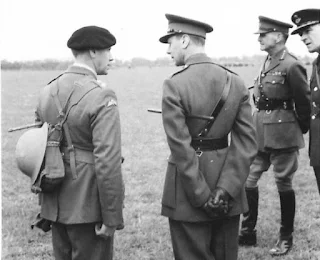Very recently Pierre, aka tcrown, of The British and Commonwealth Military Badge Forum (https://www.britishbadgeforum.com/forums/) presented a fascinating article on the very first qualification brevet awarded to the original personnel who formed what was to become The Parachute Regiment of the British Army in 1940. With his expressed permission and my full acknowledgement and sincere gratitude this blog author is presenting that same article. I have taken the liberty to incorporate a few additional notes for those who might not be familiar in detail with the real true origins of the very first “winged canopy” brevet of the regiment.
“Early Para Wings
by tcrown
Location: Canada
It is well accepted by collectors that the early parachute wings were manufactured by Lewis Falk Limited. A true characteristic of early wings is split or detached feathers.
The first wings were issued in Jan 1941 after ACI 1589 dated 28/12/1940 was published describing the badge itself and the qualifying conditions. From the photos available in the IWM (Imperial War Museum) collection, we can get an idea about the way these badges were worn at the very beginning.
(The first images are of Lt Col Ivor Jackson (CO, 11th SAS) on the occasion of a visit to the unit by then Gen Alan Brooke, C in C Home Forces, later Field Marshal Alan Francis Brooke, 1st Viscount Alanbrooke, KG, GCB, OM, GCVO, DSO & Bar), January, 1941.)
These two photos were taken in early January 1941 during a parachute demonstration before General Brooke (C in C Home Forces). Lt Col Ivor Jackson, CO of 11th SAS (the only British parachute force at the time) is pictured wearing his Para badge uncut in its full rectangular original form (I’m wondering who the officer, likely his 2nd in C, was standing next to him). Note also the parachutists in the background emplaning with their gear and newly issued smocks. They don’t wear any wings as the badge was at the time only permitted on BD. This was changed on 12 Feb 1942 (ACI 204) when wearing para badges were authorized on smocks (called officially ‘gabardine jump jacket’). (This was the fore-runner to the iconic Denison smock, and was essentially copied from the German Fallschirmjäger smock).
This photo (source: ParaData) shows members of C troop 11th SAS wearing badges on their smock. Interestingly, the second individual from the left first row (Cpl A. Phillips) was tragically killed in a parachute accident on 16 Feb 1941. We can just assume that all parachute members were eager to wear their badge once permitted.
The following rare photograph is presented with full acknowledgment and expressed gratitude to the Airborne Assault Museum at IWM, Duxford. It is a photograph of 'X' Troop of 11th SAS Battalion which assaulted the Tragino Aquaduct.
11 SAS Battalion was formed from No 2 Commando on 21 November 1940, retaining the No 2 Commando CO Lt Col CIA Jackson. In 1941 he was succeeded by Lt Col EE Down. The battalion retained its Commando structure, of 22 eight-men teams trained to infantry section standard. This was increased to 10 because the numbers conformed to a Whitley aircraft ‘stick’ of parachutists. ‘X’Troop from 11 SAS , consisting of seven officers and 28 men conducted the Tragino Aquaduct Raid in Italy on 10/11 February 1941. This was the first British parachute operation of the war. By August 1941 the unit reorganised into a conventional headquarters and four infantry companies battalion pattern. On 15 September 1941 the unit name changed to the 1st Parachute Battalion.
A photo of the recent issued badge was taken on 21 Feb 1941 (IWM) with its typical rectangular form. The split of feathers is clearly visible on both period and modern photos.
It looks like the practice of wearing the badge in an uncut form was shortly discontinued on BD as can be seen in this snapshot of a movie taken in Feb 1941 (source: IWM ‘The Service Takes to Silk’).
Lt Col Jackson himself wore trimmed wings when he presented his unit to the King in May 1941.
These type of wings although issued first, continued to be worn well beyond late war years. They are not particularly rare and the collector has to be aware that uncut (unissued) or oval shape wings don’t make them any earlier than they are.
I have added a couple of photos of trimmed examples of the same wing type that could have been issued during mid or even late war.













1 comment:
Great article, thank you!
Post a Comment